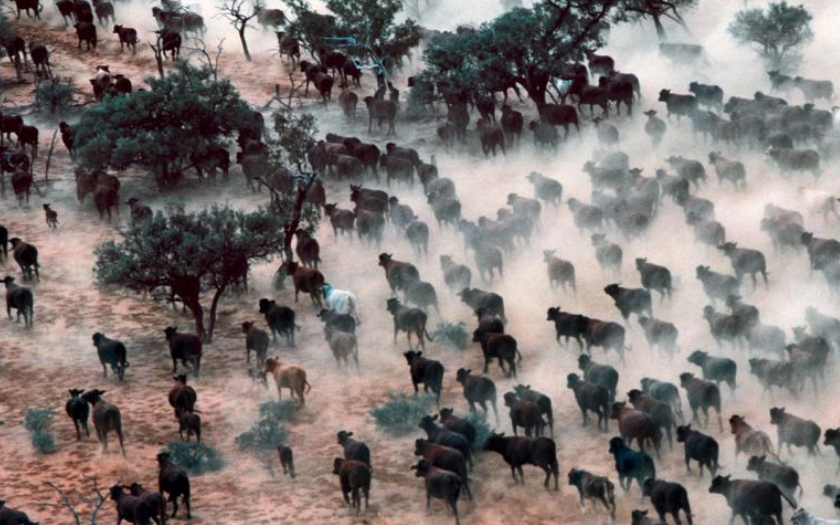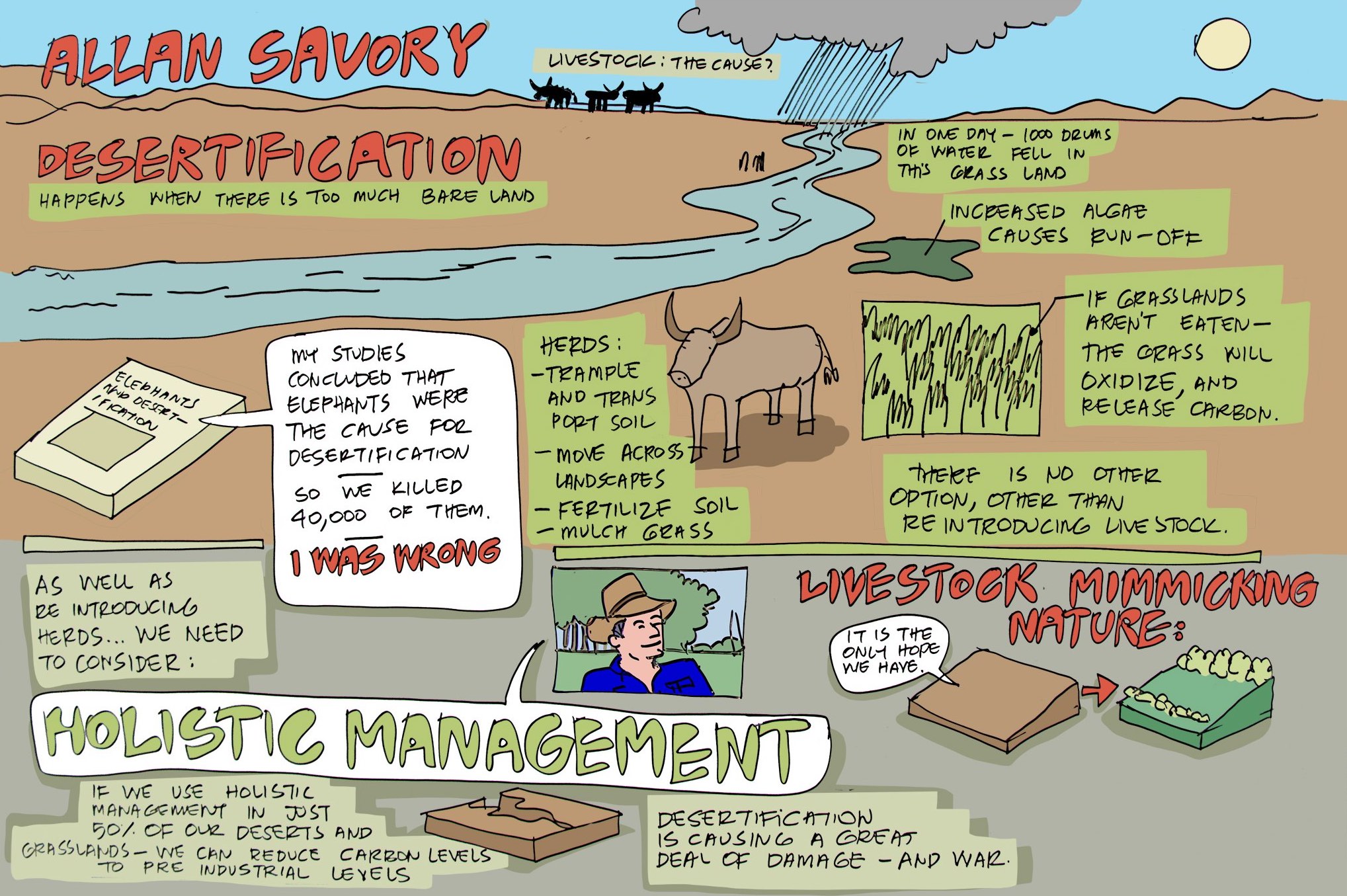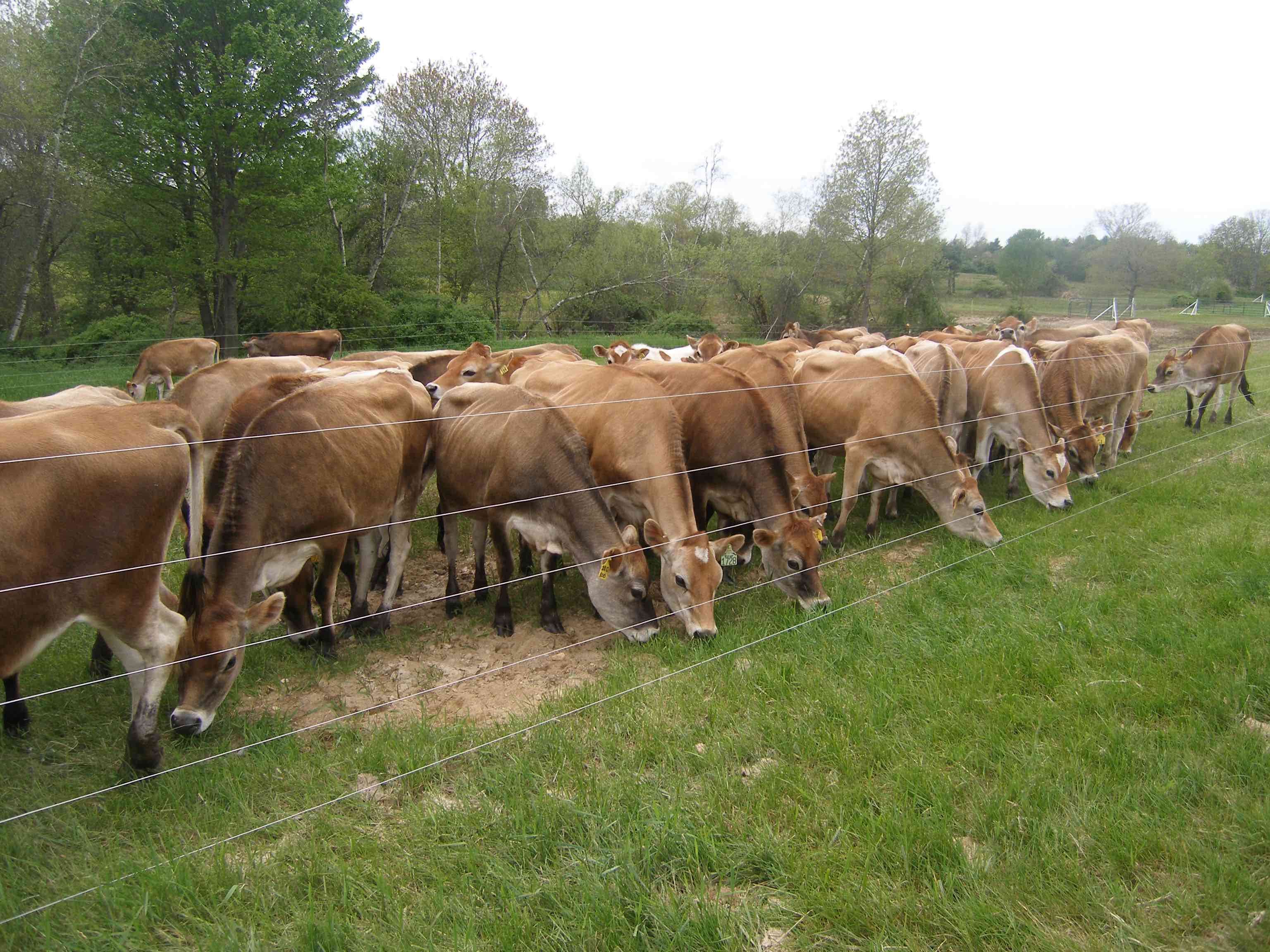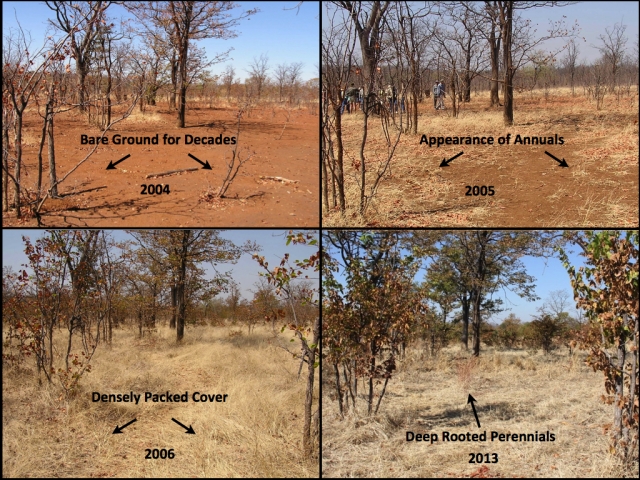
Each day brings another wave of grim stories about escaping greenhouse gases, melting glaciers, ruined and rising oceans, weather gone wild, alternating droughts and floods, and a worsening worldwide food and water crunch. Each day we are persuaded to give up a little more hope for a promising future of habitation on the surface of our damaged planet. Little do we hear about how — with a few low-tech changes in the way we farm and manage our drier lands — we can turn this around in our time: permanently and profitably. This is not theory or conjecture. This work is already succeeding in restoration outposts across the globe.
On farms and landholdings around the world there is a revolution underway that, in the words of Allan Savory, its elder prophet, “offers more hope than you can imagine”. As a young government biologist in Southern Rhodesia more than fifty years ago, Savory was tasked with halting the ongoing desertification of large national parklands. Through a series of disastrous blunders based on the universally accepted but misguided belief that any livestock and an overabundance of wild herbivores were to blame, he failed. In response, Savory set out to devote his life to resolving a mystery: What really causes productive semi-arid ecosystems to deteriorate into deserts?
His eventual revelation was surprisingly simple. All dry grasslands evolved with, and have always required, the occasional impact of animals: large herds of hoofed, grazing animals, kept bunched and moving (originally by pack-hunting predators like lions and wolves and humans) to cycle the nutrients and prepare the soil surface to absorb the eventual rains. He found that these savannahs needed to be heavily grazed, annually, for a very brief period — as well as dunged and trampled — and left alone to regenerate.
Farm the excess carbon out of the atmosphere and back into the soil; capture and keep every drop of rain that falls; make choices that favor the diverse . . .
A falling raindrop can be a terribly destructive thing. That is, unless its velocity is broken by a canopy of living plants, or a cover of natural litter, and then immediately absorbed into the carbon sponge of living soil. When raindrops fall on impervious surfaces they gather and begin to move; unabsorbed raindrops, moving in sufficient quantities, cause soil erosion — and in greater quantities, become floods. The heavy rains that should have brought blessed relief to many drought-stricken states and countries over the last few summers have instead brought devastation. The soils the rains fell on were lifeless, crusted and compacted — and could not readily receive the gift.
Of many soil scientists and farmers who share their wisdom in Youtube videos, Gabe Brown is one of the more compelling speakers. Not born to farming, in the 1980s he married a North Dakota farm girl and learned the ropes and tropes of conventional production agriculture from her father. After taking over the operation, Brown enjoyed one good harvest and then lost the next four years’ crops to hail and drought. Too broke to buy the standard chemical inputs, and in danger of losing the land, he had no choice but to improvise. He switched to the practices of no-till planting, mixed cover crops, and Allan Savory’s holistic grazing management, all of which helped to conserve soil moisture. By these means, on dry land and using no irrigation, he and his family restored organic matter (carbon) and the biological vitality to the soil. Over the years the rate of rainfall infiltration raised to an extraordinary 1500%: from 1/2 inch per hour to eight inches per hour. As a result, Brown and his family not only survived, but made a lot of money in the process.
Land with an eight inch per hour rate of rainfall infiltration does not flood, it drinks. And this fact is the key to restoring dry lands through a series of three practices: farm the excess carbon out of the atmosphere and back into the soil; capture and keep every drop of rain that falls; make choices that favor the diverse, subterranean micro-herd whose activities and interactions in the soil profile make terrestrial life possible. Following these practices will make farming profitable.

"If allowed to wander freely across an open range, they behave like untended children." [o]
Savory estimates that two thirds of the world’s landmasses are either now desert or in the process of desertification. History and science tell us that the world’s deserts were not always deserts, and that mankind is complicit in the formation of at least some of them — with fire as the most pernicious tool, and another being free-ranging hoofed livestock.
Herein lies the rub. Cows, for example — if allowed to wander freely across an open range — behave like untended children; they will bypass the broccoli and the salad bar and head straight for the dessert cart. The animals will amble around, selectively eating the sweet, tasty plants that are their favorites, and when those plants try to re-grow, the animals will return and graze them again. When this happens a few times, the favored plants’ energy reserves become exhausted and then die. Leaving the less attractive plants while killing-off the most palatable species contributes to rangeland degradation.
However, if cattle (or sheep, or goats, etc.) are bunched in large numbers and temporarily restricted to a very small piece of rangeland, the competition for limited food forces them to bite everything available in a mad scramble to eat it before some other animal eats it, or urinates or defecates on it. When a third of the plant growth on a pasture has been grazed, and much of the rest is trampled and dunged, the animals are moved to another small pasture to repeat the process. The digested or flattened residue left behind will shelter and feed the soil life. No pasture thus impacted should be grazed again for a long time, not until the affected grasses and plants have had time to entirely recuperate.
Inexpensive, portable, electric fencing is what is making this revolutionary restoration of dry grasslands possible. Nowadays small, temporary enclosures can be quickly and easily set-up and dismantled using lightweight stakes and solar- or battery-powered electrified cross-wires. When the farmer has determined how long it takes his herd to optimally graze a certain sized enclosure, he can then set up multiple adjoining paddocks each morning, connected by gateways with simple time-controlled latches which open on their own at appropriate junctures throughout the day. When that time comes, nobody needs to convince or force the animals to pass through to a fresh pasture; once they get the idea they will be waiting at the gate. And when the rains come to these fields the water will be absorbed and sequestered in place before it can run-off to cause trouble, or be lost to evaporation.
While there are armchair quarterbacks in academia or the media who trumpet their conditioned (and untested) certainty that Allan Savory’s holistic grazing management is simply too counterintuitive to possibly be right, the many converts whose dying lands and dwindling livelihoods have been restored and enhanced know better. Today Savory’s methods are being utilized to ever-improving outcomes on over fifteen million hectares of land on six continents.

Meanwhile, elsewhere in the world the traditional annual burning continues apace. As Savory says in his 2013 TED Talk [see below], “Burning one hectare [about 2.5 acres] of grassland gives off more damaging pollutants than six thousand cars, and we are burning, in Africa, every single year, more than one billion hectares of grasslands.” (In the ensuing years additional research has prompted Savory to update this estimate to “over two billion hectares per year”). According to the “Encyclopedia of Earth”, various forms of agricultural slash and burn are “practiced by 200 to 500 million people around the world currently.”
We are aware now that we are facing a crisis of disintegrating infrastructure, bridges and railways and such, which must be addressed sooner rather than later. Is there any facet of national infrastructure more important to the future than that which provides our food and drinking water? More than half of the land in North America is semi-arid, and the portion that is already desert is spreading. We have no way of knowing for sure how long these areas have been caught in this death spiral, but we do know that over the last 60,000 years North America has lost 33 out of 45 species of large mammals, and 15 of those extinctions happened suddenly and simultaneously, around twelve thousand years ago during the Younger Dryas refreeze. Most of those vanished species were herbivores and the predators that chased them around. Could the loss of this horde of large animals — having seasonal impact upon the land — have initiated disaster for western soils as well? Allan Savory thinks so. When he first visited the United States he was shocked to see our western National Parks, set aside, rested, and ungrazed (at that point for 70 years) desertifying as rapidly as any region on the African continent. But he already knew why: fertile, healthy grasslands cannot exist without large herds of grazing animals any more than large herds of grazing animals can exist without fertile, healthy grasslands.
As an illustration, when Europeans first arrived on the North American Great Plains, there were (conservatively) 30 million bison in massive herds, constantly on the move in search of fresh pasture. At that time the living topsoil beneath their hoofs ran four to eight feet deep. Once the bison herds had been slaughtered to near-extinction and the semi-arid prairie repeatedly plowed, the resulting deterioration took less than 75 years to create America’s dustbowl on those very same lands.
In his talks Gabe Brown sets out his five key points for regenerating deep, living soils on semi-arid land — while also making a healthy profit. They are: 1. No till; the least amount of mechanical disturbance possible; 2. Armor (live plants and/or residue) on the soil surface at all times; 3. Crop diversity; 4. Living roots in the ground as long as possible; 5. Animal impact.
He explains that in his soil type, with “. . . one percent organic matter in the top six inches of the soil profile you will hold about 27,000 gallons of water [per acre] . . . So, in 1993 when I started, our 5000-acre ranch could hold 256,500,000 gallons of water. That sounds like a lot, but today we can hold 810,000,000 gallons of water; that’s huge. Think of the ramifications . . . I understand there’s a reservoir called Hubbard Reservoir near you, it’s 4,060 acre feet, it will hold about 1,322,955,000 gallons of water. At the rate we’re improving our organic matter on our farm, we’re going to be over ten percent pretty soon. In other words, our 5000-acre ranch will hold more water than the Hubbard Reservoir. Soil carbon is the key driver for the nutritional status of plants, and it is the key driver for moisture-holding capacity.”

"They will bypass the broccoli and the salad bar and head straight for the dessert cart." [o]
So were we to implement nationwide (or better yet, worldwide) efforts to begin restoring all deserts to productive grasslands using these simple, proven methods, not only could we farm the excessive carbon dioxide out of the atmosphere, but we could begin lowering sea levels by capturing and holding huge amounts of rainwater in our now-functional soils — and, in time, begin refilling our depleted deep aquifers. Glaciers are not the only safe place on Earth to store fresh water. But we would need a government not in the pocket of corporate agriculture, which has its own, less altruistic priorities.
Gabe Brown farms very successfully with no chemical fertilizers, no irrigation, no insecticides, no fungicides or glyphosate, and he uses little conventional herbicide, a practice he is in the process of phasing out altogether.
And speaking of glaciers, according to an August, 2012 story by Bill McKibben, published in **Rolling Stone** called “The Arctic Ice Crisis” (and a recent follow-up called “Greenland Melting”), a young climatologist and glaciologist named Jason Box has been investigating a theory originally put forth in 2003 by the godfather of global-warming science, James Hansen: that windborne soot and dust landing on glaciers could reduce the “albedo” (the reflectivity that protects clean white ice from the sun) enough to result in surface melting, which then creates a cascade of further ice losses. Of Box’s research on “albedo”, McKibben writes, “Fresh snow bounces back 84 percent of the light that hits it; warm, rounded crystals can reflect as little as 70 percent. Slushy snow saturated by water – which gives it a gray cast, or even a bluish tint – reflects as little as 60 percent. Add dust or soot, and the albedo drops below 40 percent.”
When one considers that since the turn of the 21st century there have been over a dozen major and persistent wild fires around the planet, and that every year there are between 200 and 500 million intentional agricultural burns (not to mention ongoing massive dustbowls in northern China and northern Africa, as well as smaller regional ones elsewhere) it stands to reason that some of all that atmospheric soot, ash and dust is finding its way onto the world’s glaciers, initiating or accelerating the meltdown.
According to the Earth Policy Institute, “More than a quarter of China’s land area is covered by desert, and each year spreading sands claim additional territory. Expanding deserts in the arid northwest are merging. Since 1950, more than 24,000 Chinese villages have been abandoned or are seriously in danger of succumbing to traveling dunes, with some 35 million people directly affected. The China Meteorological Administration reports that a single severe dust storm in 2006 dumped 330,000 tons of dust from the west onto Beijing: a stunning 44 pounds for each of the city’s residents. In 2007, a dust storm originating in China’s spreading Taklimakan Desert circled the globe in just under two weeks.”
China’s is the second worst ongoing dust bowl. Africa’s is bigger.

An emerging narrative . . . the potential of restorative grazing to mitigate glaobal warming. [o]
Among the many benefits that come from restoring these deserts to biologically active grasslands using the methods promoted by Allan Savory, Gabe Brown, and many others are that healthy grasslands not only hold that soil and dust in place, but also perpetually raise the carbon content, water-holding capacity and fertility. When those grasslands are holistically grazed, the annual burning becomes unnecessary and even counter-productive. With no permanent fencing, the wildlife returns and flourishes. These methods produce food for people from marginal lands that, for a variety of reasons, should never, ever be broken by a plow, and cannot be farmed by conventional methods without degrading them further and faster.
Life begets life. There is a popular saying among the people doing this grasslands restoration that goes, “Soil without biology is merely geology.” And, lifeless geology has no means of retaining water in the root zone. But when even the most degraded and denuded lands are briefly subjected to heavy animal impact, the vitalization process immediately begins.
The action of the animals’ hoofs as they mill about searching for anything they can graze breaks the impervious surface crust and the hydrophobic dried algal mats, providing small catchments and points of entry for the eventual rains. The dropped and trampled dung piles inoculate bacteria and carbon into the top layer of soil. Each tiny change in favor of soil life moves the process forward incrementally — perhaps too incrementally to be immediately apparent — but eventually the changes become exponential. First it sleeps, then it creeps, then it leaps.
There is some principled resistance to this prescription. Much of it comes from vegetarians and vegans, who contend that raising animals for eventual harvest is a waste of food and water that otherwise could be used to feed people. That argument misses the point. Besides the fact that grass-finished beef is nutritionally superior, and presumably tastier and ever more in demand by health-minded omnivores, holistic grazing management allows the animals to consume nothing in their entire lives but the grasses and forbs that they evolved to eat. These are grasses which humans (and all other non-ruminants) cannot eat or digest, but which are the only hope for bringing life back into the soil profile of semi-arid lands. As well, holistic grazing moves animals back out onto the grasslands and away from the concentration camp model of the factory farm and the feed lot where crowded, confined conditions foster disease and pollution, where these grazing and browsing animals are force-fed and fattened with unnatural and expensive blends of grains, soybeans, bulk candy, sawdust, chicken manure (yes, really), fish meal, antibiotics and growth hormones.
Nature never gardens without animal involvement and, paraphrasing Gabe Brown, compared to the cruel factory farm and the feedlot model, his grazing animals moving from fresh pasture to fresh pasture several times a day enjoy wonderful natural lives, with only one bad day at the end. A bad day, I might add, that all living things are destined to experience, in one way or another.

Holistic management techniques in the hands of those who can make an impact. [o]
If holistic grazing were implemented on a grand enough scale, as the world’s semi-arid lands came back to life, premium grass-finished meat would become cheaper than its toxic, tortured, conventional equivalent. Nevertheless, Savory maintains, if tomorrow all the peoples of the world adopted an entirely vegan lifestyle, we would still need to employ grazing animals as proxies for the natural systems that human civilizations have always subverted, and which in return have doomed many of those same civilizations to history’s scrapheap. There is no other economically and ecologically practicable way to restore the semi-arid grasslands without the help of grazing animals replicating what wild grazing herds always did — until catastrophic planetary events and misinformed people interfered.
And then there are the jobs. In the 21st- century we will need meaningful, productive, and long-term employment for the many people who are not qualified or temperamentally suited for kind of advanced education required in much of the evolving job market. Allan Savory has successfully taught his grazing strategies to illiterate rural villagers in Africa who, once they grasped the concepts, pooled their animals and collectively managed their grazing with his methods. They are restoring their local environments while enhancing the fertility and the natural integrity of their shared farmlands.
Brown and others could be a means of assisting young people in efficient, ecologically-sound start-ups, while moving us away from the factory-farm model . . .
With the right leadership the national effort could be run like Roosevelt’s Depression-era Civilian Conservation Corps (which did much of the restoration work after our first manmade dustbowl). This sort of work with grazing animals might also be well-suited for the vast army of returned veterans suffering from PTSD and physical disabilities, as some of the people doing this work quickly set up their paddocks each morning while riding on ATVs. To conventional farmers and ranchers who have switched over to these methods, the thing that amazes and bemuses them is how much less hard they are working now to achieve far greater profits, while improving their lands — and reducing the risks of running businesses that depend upon the weather. Now the grass and plants on their lands can wait for the rains, without perishing, because the guardians are no longer squandering any of the available moisture. Some ranchers are even seeing long extinct or seasonal springs and streams come back to year-round life as an additional benefit.
This country is also losing its farmers by attrition. Our farmers are aging out, and young folks cannot, under the current circumstances, afford to begin. A national program to re-green our deserts and train aspiring young folks in the regenerative farming techniques of Savory, Brown and others could be a means of assisting young people in efficient, ecologically-sound start-ups, while moving us away from the destructive and dangerous factory-farm model that has poisoned the environment and sickened farmers and consumers alike.
Our next generation of restorative farmers must monitor and manage the daily activities of grazing animals, while allowing them to return to living a semblance of their natural, outdoor existence. The days of rich, **laissez-faire** ranchers releasing their stock to free-range across — and ruin — the public lands must end. ≈©
LINKS
• Gabe Brown, 'Keys to Building a Healthy Soil'. >
• Earth Policy Institute. 'Expanding Dustbowls Worsening Food Prospects in China And Africa.' >
• Encyclopedia of Earth: 'Slash And Burn'. >
• 'Occam’s Grazier.' An in-depth Introduction to holistic management. >

DYLAN FORD is is an organic gardener, writer and artist with a particular interest in environmentally restorative agriculture.

Comments
As a critical thinker, though
As a critical thinker, though I enjoyed reading this essay, it seemed a bit too hagiographical. While Allen Savory’s ideas sound good at first, and seem to reflect permaculture practices, something didn’t quite feel right. So I decided to do a little investigation. After reading this article [https://bit.ly/2taXT0O], I have my doubts as to the soundness of Mr. Savory’s ideas. I’m a skeptic, I admit it, and I read everything with a critical eye. Read the linked article and then come to your own conclusions.
Jeff - I would suggest you
Jeff, I would suggest you take your research a little deeper. Look at the testimonies of those who have applied Savory's methods to great success in the real world, rather than one cynical writer who has not.
Add new comment